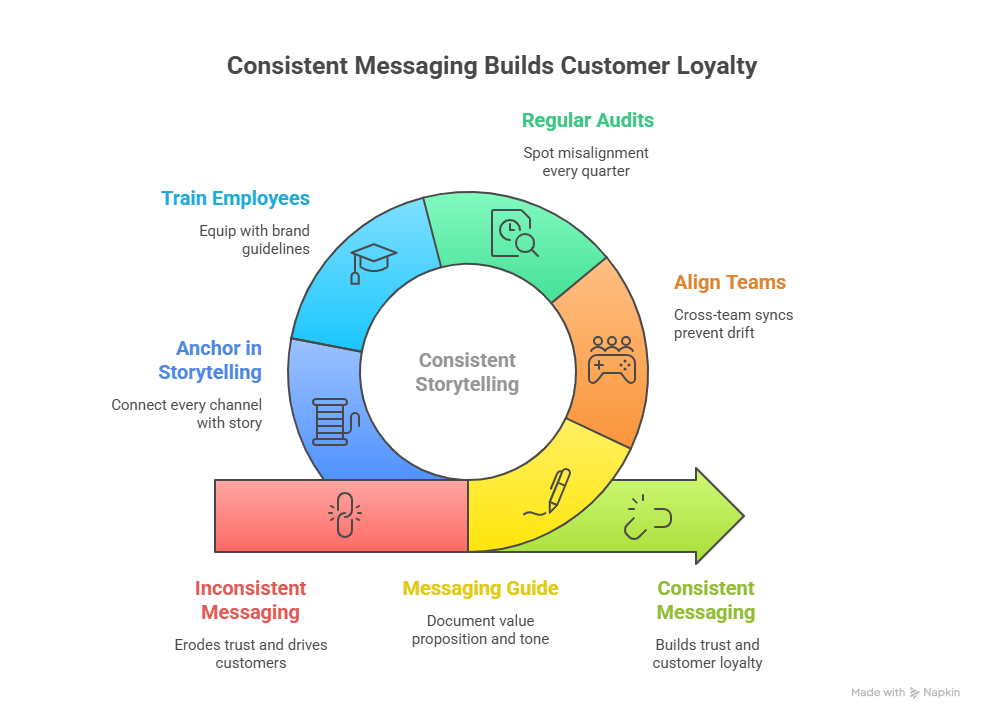Table of Contents
- What is Inconsistent Messaging?
- How Mixed Signals Erode Trust
- The Link Between Consistency and Loyalty
- The Role of Storytelling in Building Trust
- Practical Steps to Ensure Consistency
- Final Thoughts
In today’s hyper-competitive market, companies invest heavily in building customer loyalty—yet many unknowingly sabotage it. The culprit? Inconsistent messaging.
Whether it’s a confusing website, contradictory social media posts, or mismatched sales pitches, inconsistent communication silently erodes trust and drives customers away. The good news? With the right approach, consistent storytelling can turn things around.
1. What is Inconsistent Messaging?
Inconsistent messaging happens when a brand communicates differently across channels or teams. For example:
- Marketing says your product is the most affordable.
- Sales emphasizes premium quality and exclusivity.
- Customer support highlights speed over price or quality.
This doesn’t just confuse customers—it creates uncertainty about your brand’s true value. If your messages don’t align, your audience will fill in the blanks themselves, often in ways that don’t favor your business.
Many companies fall into this trap because they try to please everyone. They push one message to attract budget-conscious customers, another to appeal to premium buyers, and yet another for existing users. Without a central narrative, these fragmented signals clash. Instead of broadening appeal, they dilute your brand identity.
Consistency doesn’t mean saying the same thing everywhere—it means communicating the same essence. A company can emphasize affordability in one campaign and premium quality in another, but both should tie back to a shared, overarching story.
2. How Mixed Signals Erode Trust
Trust is the foundation of customer loyalty. When your messaging is inconsistent, customers start to question:
- “Do they really understand their own value?”
- “Can I trust what they’re promising?”
- “Will my experience match what I was sold?”
These doubts are subtle but powerful. Imagine buying from a brand that claims “luxury and exclusivity” on Instagram but blasts “lowest price guaranteed” in an email. As a customer, you’d be left wondering—what’s the truth? The disconnect makes you hesitant to buy, and even more hesitant to return.
Mixed signals also disrupt the customer journey. Someone who discovers your product on social media expects the same tone and value when they visit your website. If they encounter conflicting information, the smooth journey turns bumpy. That friction can be enough to push them to a competitor.
Research shows that brands with consistent messaging are 3.5 times more likely to enjoy strong brand visibility. Visibility isn’t just about being seen—it’s about being seen as reliable. Without that reliability, your audience won’t stick around long enough to build loyalty

3. The Link Between Consistency and Loyalty
Consistency doesn’t just make your brand look polished—it creates a sense of reliability. Customers know what to expect, and over time, this predictability fosters loyalty.
Think about your favorite coffee shop. Part of why you return isn’t just the taste—it’s the consistent experience. The same applies to brands. When customers repeatedly encounter aligned messages, designs, and promises, they feel reassured. That reassurance turns into habit, and habit turns into loyalty.
Global brands like Apple, Nike, and Starbucks are masters of consistency. Their campaigns may evolve, but their core message remains the same. Apple emphasizes innovation and simplicity. Nike focuses on inspiration and empowerment. Starbucks reinforces community and connection. This clarity makes customers feel confident investing their time, money, and trust.
Inconsistency, on the other hand, forces customers to reevaluate your brand every time they interact with it. That constant re-evaluation is exhausting—and no one wants to work hard to stay loyal.
4. The Role of Storytelling in Building Trust
The most effective way to achieve consistency is through brand storytelling.
A brand story aligns your message across platforms by focusing on:
- Your “why” (the purpose behind your brand)
- Your “how” (the unique way you deliver value)
- Your “what” (the products or services you offer)
Storytelling humanizes your brand and ensures that every message connects back to a bigger narrative. Instead of fragmented campaigns, you create a seamless thread that customers can easily follow.
For example, Patagonia doesn’t just sell outdoor gear—it tells the story of protecting the environment. Every ad, product description, and campaign reinforces that story. Customers don’t just buy jackets; they buy into the mission. That alignment is what makes storytelling such a powerful driver of loyalty.
When storytelling is done right, your brand stops sounding like a marketer and starts sounding like a trusted partner. And customers don’t just listen—they remember.
5. Practical Steps to Ensure Consistency
Here are actionable ways to avoid mixed signals and build trust through consistency:
- Create a Brand Messaging Guide – Document your value proposition, tone of voice, and key messages. This ensures that whether it’s a social post, sales pitch, or customer support script, everyone stays on brand.
- Align Teams Across Functions – Misalignment often starts internally. Marketing may chase one audience, while sales targets another. Regular cross-team syncs prevent this drift.
- Audit Regularly – Consistency isn’t a one-time project. Review websites, social media, and campaigns every quarter to spot misalignment.
- Train Your People – Employees are your first brand ambassadors. Equipping them with brand communication guidelines prevents them from unintentionally sending mixed messages.
- Anchor in Storytelling – Use your brand story as the thread connecting every channel. When you tell the same story differently in different places, it feels fresh but still aligned.
Consistency doesn’t mean rigidity. Brands should evolve with trends and audiences, but evolution should always build on a steady foundation. When in doubt, return to your story—it will guide the way.
6. Final Thoughts
Inconsistent messaging may not scream for attention, but it quietly chips away at the loyalty you’ve worked hard to build. Customers may not articulate the disconnect, but they feel it—and that feeling is often enough to break trust.
On the flip side, consistent storytelling creates clarity, builds trust, and turns customers into advocates. The brands that thrive aren’t necessarily the loudest—they’re the clearest. They know what they stand for, and they communicate it without wavering.
If you want loyalty that lasts, make sure your brand speaks with one clear, unified voice—always.




